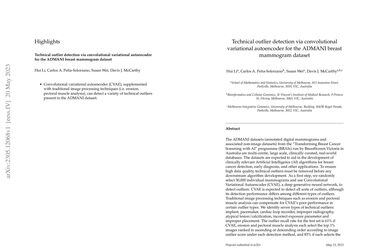Technical outlier detection via convolutional variational autoencoder for the ADMANI breast mammogram dataset
The ADMANI datasets (annotated digital mammograms and associated non-image datasets) from the Transforming Breast Cancer Screening with AI programme (BRAIx) run by BreastScreen Victoria in Australia are multi-centre, large scale, clinically curated, real-world databases. The datasets are expected to aid in the development of clinically relevant Artificial Intelligence (AI) algorithms for breast cancer detection, early diagnosis, and other applications. To ensure high data quality, technical outliers must be removed before any downstream algorithm development. As a first step, we randomly select 30,000 individual mammograms and use Convolutional Variational Autoencoder (CVAE), a deep generative neural network, to detect outliers. CVAE is expected to detect all sorts of outliers, although its detection performance differs among different types of outliers. Traditional image processing techniques such as erosion and pectoral muscle analysis can compensate for the poor performance of CVAE in certain outlier types. We identify seven types of technical outliers: implant, pacemaker, cardiac loop recorder, improper radiography, atypical lesion/calcification, incorrect exposure parameter and improper placement. The outlier recall rate for the test set is 61% if CVAE, erosion and pectoral muscle analysis each select the top 1% images ranked in ascending or descending order according to image outlier score under each detection method, and 83% if each selects the top 5% images. This study offers an overview of technical outliers in the ADMANI dataset and suggests future directions to improve outlier detection effectiveness.
PDF Abstract
